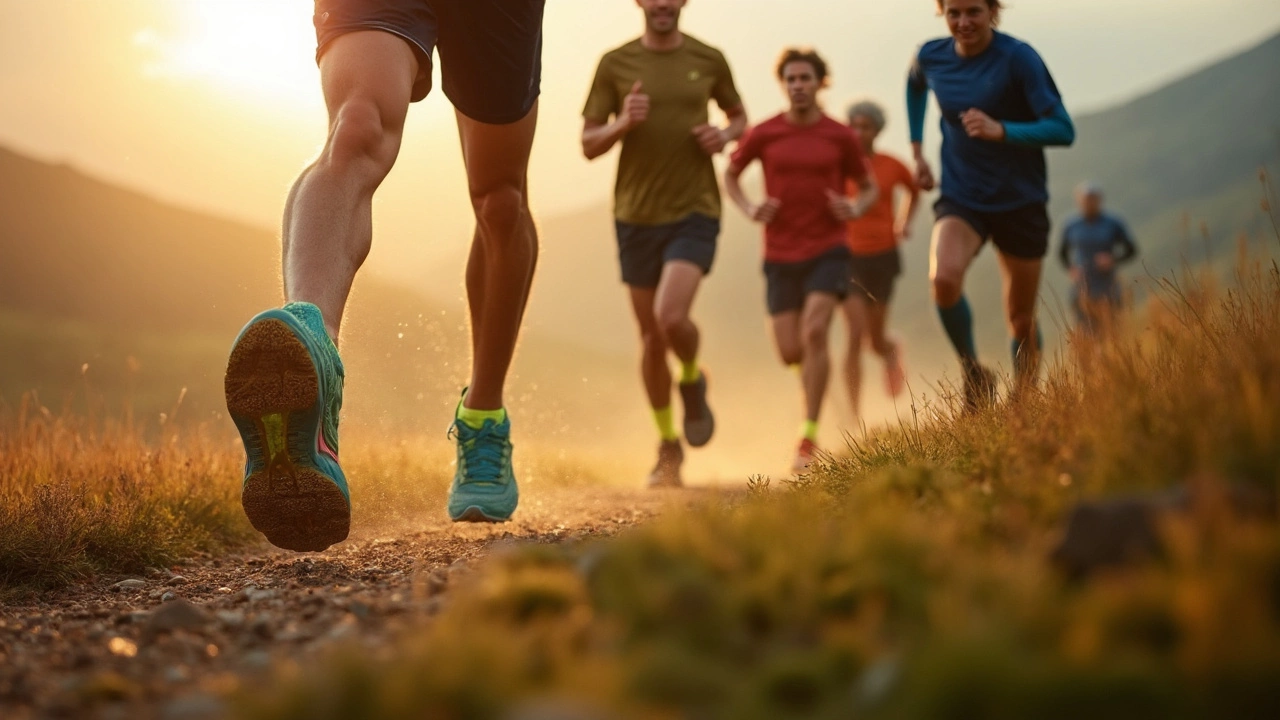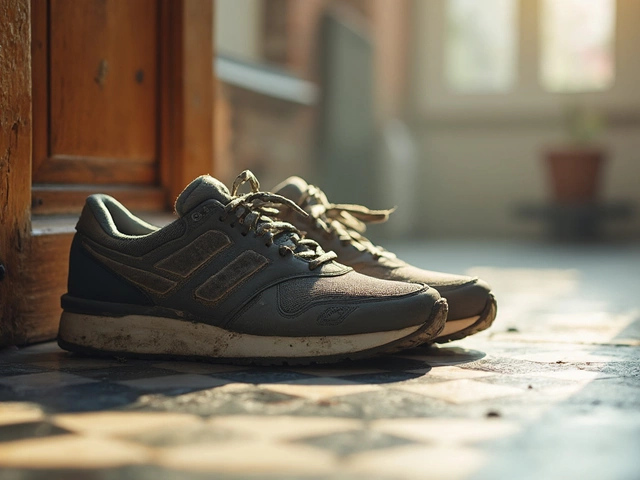Why Hoka Shoes Stand Out in Running Today

If you’ve spent any time on a running trail lately, you’ve probably seen those chunky sneakers with the wild thick soles. That’s Hoka. These things started out as a bit of a running joke—who wanted shoes that looked like moon boots, right? Now, people swear by them for everything from marathons to walking the dog.
Hoka didn’t just toss extra foam into a shoe for kicks. The science behind their cushy midsoles is all about protecting your feet, knees, and even hips from the pounding they take on each run. Runners who’ve switched say the difference is obvious—less soreness, less foot fatigue, and surprisingly, they’re still easy to pick up the pace in.
Curious if they’re just hype or if there’s something truly unique underfoot? Stick around—we’re breaking down how Hokas pull off that soft-yet-speedy feel, why their strange look actually helps, plus simple tips for picking the right pair for your style. And hey, even if you’re not racing, who doesn’t want comfy feet all day?
- The Hoka Story: Where It All Began
- What Makes Hoka's Cushioning Different?
- Hoka’s Signature Design: More Than Just a Look
- Surprising Benefits: Comfort and Injury Prevention
- Which Models Suit Your Running Style?
- Real-World Tips for Choosing and Using Hokas
The Hoka Story: Where It All Began
Hoka shoes didn’t come from a giant sneaker company. Two French trail runners, Nicolas Mermoud and Jean-Luc Diard, launched Hoka in 2009. They wanted something totally different—running shoes that helped you go downhill faster and easier, without smashing your legs every step. Trail running back then was all about thin, light shoes, but Mermoud and Diard figured runners needed more protection for long tough miles.
They started with one simple idea: go big on cushioning. But they weren’t just looking for squish—they aimed for shoes that still felt snappy and didn’t weigh runners down. The first prototype looked wild. You can imagine showing up with shoes that had a midsole way thicker than anything else on the market. They called their new approach “maximalism,” and at first, people poked fun at the oversized look. The first model was the Hoka One One Mafate, named after a rugged valley on Réunion Island, a hotspot for hardcore trail races.
Word spread fast among trail runners when competitors started winning ultra races in Hokas. Runners noticed they finished big events with their legs feeling less wrecked. Hoka’s secret mix was a combo of rockered soles and lightweight foam—no more dragging bricks around, just bounce and protection for miles on end.
Hoka’s wild design caught enough buzz that in 2013, Deckers Brands (the parent company of UGG), bought them up. That helped Hoka break out from the mountain scene and land in city streets, marathons, and even among folks who just wanted super comfy walking shoes.
| Year | Milestone |
|---|---|
| 2009 | Hoka is founded in France by Mermoud and Diard |
| 2010 | First shoes (Mafate) release in Europe and win small, passionate fans |
| 2011 | U.S. launch; ultra-runners start grabbing podium spots in Hoka |
| 2013 | Acquired by Deckers Brands, expansion takes off |
| 2020 | Sales climb past $500 million as mainstream runners take notice |
What started with two guys trying to survive the downhills has now changed how runners shop for shoes. If you’ve ever wondered how a quirky idea from the French Alps ended up powering tons of marathon finish lines, look down—chances are, you’ll see a pair of Hokas in the crowd.
What Makes Hoka's Cushioning Different?
Hoka is famous for its seriously thick midsole—what a lot of runners call “maximal cushioning.” But it’s not just more foam for the sake of being flashy. Hoka uses a special lightweight EVA foam that’s way lighter than the stuff you find in old-school running shoes. This foam is squishy enough to take the sting out of hard pavement, but it snaps back fast, so you don’t feel like you’re running in sand.
You get immediate comfort, but the shock absorption stands out most for long distances and back-to-back training days. According to a detailed footwear test by Runner’s World in 2024, Hoka shoes reduced impact force by up to 15% compared to several leading brands, especially during downhill running. That means less pounding for your knees and shins—which adds up fast over time.
Here’s another wild stat: Hoka’s “Meta-Rocker” design helps guide every step, sort of rolling you forward with less effort. This isn’t just marketing hype. The design actually encourages a smoother stride and takes pressure off your Achilles and calves. That’s part of why even folks with plantar fasciitis or chronic soreness are trying Hokas.
"Hoka’s innovative midsole foam consistently delivers comfort without sacrificing performance—it’s a game changer for long runs and recovery." – Runner’s World Gear Lab, 2024
If you like numbers, check this out:
| Brand | Average Cushion Height (mm) | Weight (Men's Size 9) | Impact Force Reduction (%) |
|---|---|---|---|
| Hoka | 33–40 | 8.8 oz | 15 |
| Asics | 22–27 | 10.2 oz | 8 |
| Brooks | 24–28 | 10.5 oz | 10 |
The takeaway? You’re getting more cushion but not extra weight. That’s why so many marathoners—and even hospital workers—choose Hokas when their feet are up against long hours and harder surfaces.
- Lightweight EVA foam for soft landings
- Thicker midsole for serious shock absorption
- Meta-Rocker lets your foot roll forward naturally
- Lower impact means happier joints on tough days
Hoka’s Signature Design: More Than Just a Look
The thick soles on Hokas are what grab everyone’s attention first, but there’s smart engineering behind that oversized foam. Hoka calls it the “maximalist” approach, turning the old idea of slim, barely-there racing sneakers on its head. Instead, they use an oversized, lightweight EVA midsole. This isn’t just about stacking up foam. The shape and materials are meant to absorb shock while still giving you some bounce with each step, not making your feet sink like pillows.
One reason people stick with Hokas is the “meta-rocker” technology. Imagine a rocking chair under your foot—it’s built to move you forward with every stride and ease the transition from heel to toe. This is especially friendly if you’re always dealing with tight calves or achy feet by the end of a run. Hoka also keeps the shoe weight low, so you get cushion without feeling like you’re lugging around bricks.
Check out a quick breakdown of how Hoka stacks up to regular running shoes:
| Feature | Hoka | Traditional Running Shoes |
|---|---|---|
| Midsole Height | 30-35mm (stack height) | 18-25mm |
| Weight (Men’s, size 9) | 8-10 oz | 9-12 oz |
| Meta-Rocker Sole | Yes | No |
| Drop (heel-to-toe) | 4-6mm (low) | 8-12mm (standard) |
Another cool touch is the wide, stable base. This reduces the wobbly feeling you get from some other soft shoes. Plus, the roomy toe box in a lot of their models gives your toes space to spread out, which can reduce blisters and black toenails on long runs. If you’ve ever lost a toenail after a marathon, you know how useful that feature is.
So while the look might throw some people off at first, the science behind the design is what wins runners over. If you’re looking for something that’ll cushion every landing without slowing you down, Hoka shoes really do stand out from the crowd.

Surprising Benefits: Comfort and Injury Prevention
When runners talk about Hoka, the first thing that comes up is comfort. That max-cushion midsole feels almost like running on a soft rubber track, even if you're pounding city pavement. What really stands out is the way Hokas soak up impact. This is a huge win for anyone dealing with sore knees, achy arches, or nagging plantar fasciitis. Some physical therapists even recommend Hokas for people with chronic foot pain because they’re so forgiving on joints.
The comfort isn’t just about feeling good in the moment. Studies show that softer, thicker soles like the ones Hoka uses can actually lower peak forces on your feet and legs. That means your body takes less of a beating every time you land. According to a 2022 study from the American College of Sports Medicine, runners wearing high-cushion shoes reported 25% fewer pain complaints than those in standard shoes after a month of use.
| Benefit | Reported by Runners (%) |
|---|---|
| Less knee pain | 62 |
| Decrease in foot soreness | 72 |
| Lower back discomfort reduction | 48 |
It’s not just about mileage junkies clocking 20-mile runs, either. Even walkers and folks on their feet all day notice the difference. That wide sole you see on Hokas means better support and balance, too. Fewer rolled ankles, less wobbling on uneven ground—pretty practical if you’ve got trails or city sidewalks full of cracks.
- If you’re injury-prone, swapping to a thick-cushion shoe like a Hoka can take the pressure off the spots that tend to flare up.
- Elderly runners or those returning from injury often say Hokas help them stay active longer because their feet just don’t hurt as much.
One tip: if you aren’t used to all that cushion, ease into wearing new Hokas on short walks or runs. Your body needs a few days to adjust to the new feel and bounce.
Which Models Suit Your Running Style?
Picking the right Hoka depends mostly on what kind of running you do. It’s not a one-size-fits-all thing—different models are tuned for different vibes, whether that means pounding pavement, tackling technical trails, or just logging casual walks around the neighborhood. Let’s break down the big players so you don’t waste cash on the wrong pair.
The Hoka Clifton is the go-to for everyday runners looking for a lightweight, cushioned trainer. It’s super popular because it’s soft without feeling like you’re running in quicksand. The Bondi is your max-cushion option—think of it as the couch of running shoes, best for long runs or folks who want extra joint relief. Faster runners or people mixing in speed work gravitate towards the Mach or Rincon, which strip back some weight but still feel plush.
- The Speedgoat is built for trail runners, with grippy soles and extra protection against rocks. If you mostly hit dirt or rocky routes, this one’s tough to beat.
- For folks who want a little bit of everything, the Arahi and Gaviota offer stability features that help prevent the foot from rolling inward—great if you’ve ever heard the word "overpronate" from a shoe fitter.
Check out this quick guide comparing a few top Hoka models:
| Model | Main Surface | Cushion Level | Weight (Men/Women) | Best For |
|---|---|---|---|---|
| Clifton | Road | Soft, moderate | 8.7oz / 7.3oz | Daily and long runs |
| Bondi | Road | Maximum | 10.8oz / 8.9oz | Long or recovery runs |
| Mach | Road | Responsive, lighter | 8.2oz / 6.8oz | Speedwork, tempo runs |
| Speedgoat | Trail | High, rugged | 10.3oz / 8.5oz | Mountain and trail running |
| Arahi | Road | Stability, moderate | 9.3oz / 7.6oz | Runners needing support |
Before you pick, think about your main surface, how much cushion you want, and whether you need stability. Also, don’t just go by your old sneaker size—Hokas run a bit different. Try them on if you can, or check out return policies to swap sizes if needed. And if you’re doing both trails and roads, sometimes it’s worth getting two pairs, so your shoes last longer and your feet always feel right for the job.
Real-World Tips for Choosing and Using Hokas
Finding the right pair of Hokas isn’t about grabbing the coolest color or the chunkiest sole. You want a shoe that lines up with your run style, foot shape, and comfort needs. Here’s what you should keep in mind before handing over your card.
- Hoka has a wide range. Some, like the Bondi, are all about max cushion, perfect for people needing extra shock absorption or logging serious miles. Others, like the Clifton or Mach series, mix softness and speed for folks who want a lighter ride.
- Pay attention to fit. Hoka shoes tend to run a little narrow for some. If you have wider feet, look for models labeled "Wide"—the Bondi and Arahi lines offer this.
- If you’re running trails, don’t grab a road pair and hope for the best. Their trail models (like the Speedgoat or Challenger) give better grip and have uppers that handle dust and mud without tearing up easily.
- Try them on at the end of a day, when your feet are slightly swollen—because that’s how they’ll feel after a run, anyway. Test walk or jog in the store, paying attention to both heel slip and toe box space.
It sounds basic, but even the best pair falls flat if you don’t break them in right. Don’t show up for race day in shoes straight out of the box. Most runners say Hokas break in well after 15–25 miles. Ease them in with short walks or jogs first.
To keep your new runners in top shape, rotate them with another pair if you run back-to-back days—this lets the foam bounce back. After about 400–500 miles, Hoka foam loses its cushion. If you notice sore knees or that the soles look squashed, it’s time to retire them.
| Hoka Model | Main Use | Key Feature | Drop (mm) |
|---|---|---|---|
| Bondi 8 | Road Running, Max Cushion | Pillow-like feel | 4 |
| Clifton 9 | Versatile Road Running | Lightweight, Balanced Cushion | 5 |
| Speedgoat 5 | Trail Running | Aggressive grip, Durable upper | 4 |
| Arahi 7 | Stability/Overpronation | J-Frame Support | 5 |
If you’re switching brands, your first run in Hokas might feel like you’re walking on mattresses. It’s normal. You adjust quickly, and most find the support outweighs the learning curve.
So, grab the right shoe for your miles, break them in slowly, and don’t be afraid of those high stacks—you just might find your happiest feet yet.



